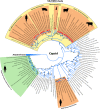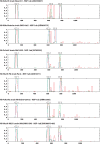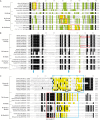Nonsuppurative (Aseptic) Meningoencephalomyelitis Associated with Neurovirulent Astrovirus Infections in Humans and Animals
- PMID: 30158300
- PMCID: PMC6148189
- DOI: 10.1128/CMR.00040-18
Nonsuppurative (Aseptic) Meningoencephalomyelitis Associated with Neurovirulent Astrovirus Infections in Humans and Animals
Abstract
Astroviruses are thought to be enteric pathogens. Since 2010, a certain group of astroviruses has increasingly been recognized, using up-to-date random amplification and high-throughput next-generation sequencing (NGS) methods, as potential neurovirulent (Ni) pathogens of severe central nervous system (CNS) infections, causing encephalitis, meningoencephalitis, and meningoencephalomyelitis. To date, neurovirulent astrovirus cases or epidemics have been reported for humans and domesticated mammals, including mink, bovines, ovines, and swine. This comprehensive review summarizes the virology, epidemiology, pathology, diagnosis, therapy, and future perspective related to neurovirulent astroviruses in humans and mammals, based on a total of 30 relevant articles available in PubMed (searched by use of the terms "astrovirus/encephalitis" and "astrovirus/meningitis" on 2 March 2018). A paradigm shift should be considered based on the increasing knowledge of the causality-effect association between neurotropic astroviruses and CNS infection, and attention should be drawn to the role of astroviruses in unknown CNS diseases.
Keywords: animal; astrovirus; encephalitis; human; meningitis; meningoencephalomyelitis; neurotropic; neurovirulent.
Copyright © 2018 American Society for Microbiology.
Figures










References
-
- Long MT. Overview of meningitis, encephalitis, and encephalomyelitis. MSD veterinary manual. http://www.msdvetmanual.com/nervous-system/meningitis,-encephalitis,-and... Accessed 2 November 2017.
-
- World Organization for Animal Health. 2004. Manual of diagnostic tests and vaccines for terrestrial animals, 5th ed World Organization for Animal Health, Paris, France.
Publication types
MeSH terms
LinkOut - more resources
Full Text Sources
Other Literature Sources
Medical

